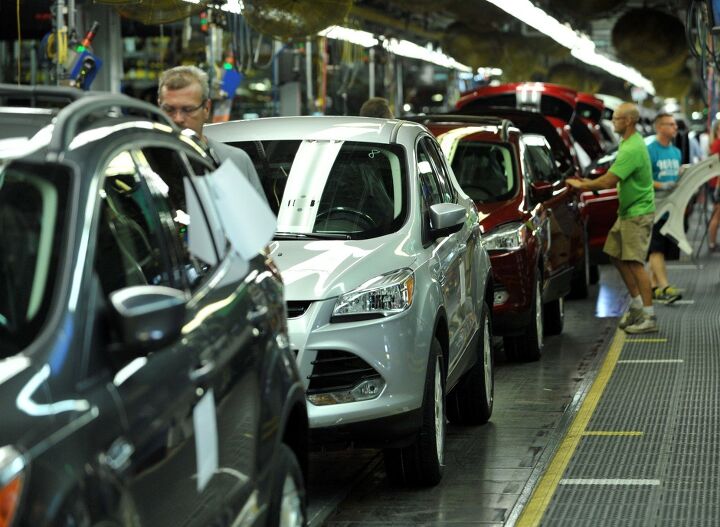Ford Tries To Increase North American Capacity, Escape & Fusion in High Demand, Short Supply
After adding 600,000 units to its North American capacity within the past two years, Ford is trying to find ways to increase output of the Escape crossover and midsize Fusion, both of which currently have about 40 days supply. The Fusion is particularly in short supply on the east and west coasts, a good sign for any domestic automaker these days. A 60 day supply of cars in inventory is generally considered normal for the U.S. auto industry. Automotive News is reporting that at the Center for Automotive Research’s Management Briefing Seminars, held in Traverse City, Michigan, Ford VP for North America manufacturing, Jim Tetreault, said, “We’re still looking at how we get more out of every plant, and that’ll be a focus for as long as the demand is as strong as it is.”
One option is adding a third shift at the Flat Rock Assembly Plant, which currently builds Mustangs and a second shift is being added to start building Fusions. Adding capacity at the Louisville Assembly Plant, where the Escape is put together, will be done by speeding up the assembly line. Tetreault said that increasing speed by 2 Escapes an hour would give the automaker another 240 vehicles a week to sell. He said that squeezing out even one more car or light truck an hour would be worthwhile.
So far, Ford has used a combination of adding shifts and increased use of relief and floating employees to keep the lines humming at its 30 plants in North America. The automaker also has twice weekly meetings including manufacturing and purchasing managers along with “supplier technical assistance leaders” to look for capacity improvements. Another area of improvement has been through better equipment maintenance. Ford says that production was improved by 3% just by “better up-time” and new equipment purchases. Attention to ergonomics on the assembly line is also expected to yield greater productivity. Employee health, both reducing on the job injuries and identifying employees at risk for chronic illnesses and providing them with health advice, is also seen as a means of improving capacity by reducing absenteeism.
Ford has been increasing its human resources, with 8,000 hourly and 3,000 salaried employees hired within the last 5 quarters. That leaves Ford with a current total of 82,300 workers in North America. Tetreault doubted that Ford will ever see the kind of employment levels it had before the recession, even with continued growth in the U.S. market.
More by TTAC Staff
Latest Car Reviews
Read moreLatest Product Reviews
Read moreRecent Comments
- ToolGuy The other day I attempted to check the engine oil in one of my old embarrassing vehicles and I guess the red shop towel I used wasn't genuine Snap-on (lots of counterfeits floating around) plus my driveway isn't completely level and long story short, the engine seized 3 minutes later.No more used cars for me, and nothing but dealer service from here on in (the journalists were right).
- Doughboy Wow, Merc knocks it out of the park with their naming convention… again. /s
- Doughboy I’ve seen car bras before, but never car beards. ZZ Top would be proud.
- Bkojote Allright, actual person who knows trucks here, the article gets it a bit wrong.First off, the Maverick is not at all comparable to a Tacoma just because they're both Hybrids. Or lemme be blunt, the butch-est non-hybrid Maverick Tremor is suitable for 2/10 difficulty trails, a Trailhunter is for about 5/10 or maybe 6/10, just about the upper end of any stock vehicle you're buying from the factory. Aside from a Sasquatch Bronco or Rubicon Jeep Wrangler you're looking at something you're towing back if you want more capability (or perhaps something you /wish/ you were towing back.)Now, where the real world difference should play out is on the trail, where a lot of low speed crawling usually saps efficiency, especially when loaded to the gills. Real world MPG from a 4Runner is about 12-13mpg, So if this loaded-with-overlander-catalog Trailhunter is still pulling in the 20's - or even 18-19, that's a massive improvement.
- Lou_BC "That’s expensive for a midsize pickup" All of the "offroad" midsize trucks fall in that 65k USD range. The ZR2 is probably the cheapest ( without Bison option).


































Comments
Join the conversation
Well, I guess that explains the casual fit of the body panels...
Would not touch a Ford with a 10 ft pole. Crappy company and crappy cars. Friend's dad had a 2 year old Fusion in the shop for 2 months straight. Ford refused to lemon the car and only reimbursed for one month of his payments. He was going to buy the new MKZ, instead he bought a new, fully loaded Azera with the tech package and loves it. He will never touch a Ford again. There are so many recalls and problems with Fords it is not funny.